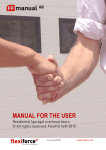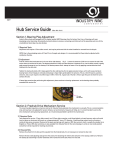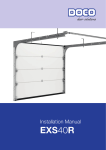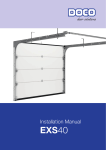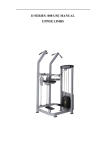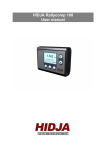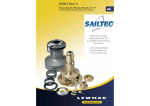Download 02 User manual industial door
Transcript
manualGBNL manual USER GUIDE industrial (sectional) overhead doors © All rights reserved. FlexiForce® 2010 USER GUIDE IND www.flexiforce.com manual GB ATTENTION! GENERAL WARNINGS! To use, operate and service this overhead door safely, a number of precautions must be taken. For the safety of all concerned pay heed to the warnings and instructions given below! If in doubt, contact your supplier. ! This manual only describes the operation and servicing of an industrial overhead door. Probably it has to be supplemented with instructions for any additional components. Before starting, read this manual carefully. Certain components may be sharp or have jagged edges. As such you are advised to wear safety gloves. All the components which have been supplied are designed for use with this specific overhead door. Including additional components may have an adverse effect on the safety of, and the guarantee on, the door. Do not let children or other not-qualified persons operate this door. They can encounter severe danger during operation. All rights derived from this manual are reserved. Technical information is subject to change without notice. Your supplier has the obligation to “hand-over” this door conforming the local laws and demands. Check yourself if the needed CE-marks are placed on the door and if you have received the needed documents (CE-declarations). AN OVERHEAD DOOR IS A HEAVY AND BIG MOVING OBJECT. FAULTY OPERATION, MALFUNCTIONING OR NON-CAREFULL TREATMENT CAN CAUSE SEVERE INJURIES OR DANGER!! IF SUBJECTS ARE NOT CLEARLY SPECIFIED IN THIS MANUAL, PLEASE CONTACT YOUR SUPPLIER! BE CAREFULL AT ALL TIMES WHEN USING THIS OVERHEAD DOOR. ! ! ! ! ! ! ! INDEX 1. 2. 3. 4. 5. 6. 7. 8. 9. User application Functional principle Opening and closing 3.1 Manual operation 3.2 Electrical operation 3.2.1 Operating with an operating panel 3.2.2 Operating with a handheld transmitter 3.3 Chain hoist operation Locking Pass door Improper use Safety devices 7.1 Spring breaking device 7.2 Safe edge 7.3 Cable breaking device 7.4 Slack cable device Reparation, maintenance and breakdowns Supply conditions and terms ENTRAPMENT DANGER! CUTTING DANGER! USER GUIDE IND page 3 page 3 page 3 page 3 page 3 page 3 page 4 page 4 page 5 page 6 page 6 page 6 page 6 page 6 page 6 page 6 page 7 Attached ATTENTION! DANGER! 2 manual GB C USE OF TERMS AND WARNING SIGNS B ATTENTION! SAFETY INSTRUCTIONS FOR THIS DOOR B Unsafe installation, service or use of this overhead door can cause serious danger or injuries. Make sure this door is CE-marked! For safety follow these instructions: A. Installation, maintenance or repairs can only be done by qualified and experienced overhead door mechanics! B. Before installing, repairing or servicing this door, the mechanic should read the installation manual. If there is no manual at the site, do not install, repair or service this door! C. Keep away from a moving door. A moving door is a large, heavy object and can cause serious danger or injuries! D. Children should not be allowed to operate this door! E. Always keep the door in sight when you operate it with use of a remote control system. People (children) or objects may stand in the way! F. Keep fingers away from the panels, tracks and other moving objects on this door! Only use available handles to move the door manually! G. Make sure this door is inspected and maintained regularly. C C A A 3 4 6 7 8 9 10 12 13 14 15 16 17 18 19 20 21 22 Chain hoist (operation) Side- and intermediate hinges Running track (guidance) Vertical angle Lock bolt for locking the door Handgrip/foothold Bottom bracket or cable break device Bearing plates (shaft system) Shaft (axle) Balancing torsion springs Coupler Balancing torsion springs Cable drums with lifting cable Suspension to ceiling Suspension to ceiling Horizontal running track Spring bumpers Connection between hor. tracks B A DANGER! TORSION SPRINGS ARE UNDER EXTREME TENSION! DO NOT TRY TO ADJUST, REPAIR OR REMOVE THE SPRINGS. This can cause serious danger and injuries. Qualified mechanics: Read the manual before installation or repairs! USER GUIDE IND DANGER! This bottom bracket is under extreme tension! DO NOT TRY TO REPAIR, REMOVE OR ADJUST! While this can cause serious danger or injuries, contact a qualified mechanic! 3 manual GB 1. USER APPLICATION The overhead door is intended for the closure of an opening in a building. The overhead door may not be used for other purposes. The overhead door, with the exception of the pass door, is not intended for access by persons. ! Before carrying out work on the overhead door read this user handbook carefully! The supplier is not responsible for any damage caused by improper use of the overhead door. 2. OPENING Take the door by the handgrip and pull up. Raise the door with sufficient force that it can still be stopped by hand; do not « throw » it open. CLOSING Take the door by the handgrip or cord and pull it down. OPERATE THE DOOR ONLY BY THE HAND GRIP OR ROPE. OTHER PARTS ARE NOT SUITABLE FOR OPERATING THE DOOR! FUNCTIONAL PRINCIPLE On each side of the door panels there are tracks to provide guidance. Above the door panel there is the transmission shaft with balancing springs, cable drums and spring breaking devices. The door panel is suspended from steel cables that wrap around the cable drums when the door is opened. The balancing springs ensure that the door panel can remain stationary in any position with manual power. The balancing springs are at maximum tension when the door is closed. UNDER NO CIRCUMSTANCES DISASSEMBLE THE CABLE, CABLE DRUM OR BALANCING SPRINGS. THIS MUST BE DONE ONLY BY PROPERLY QUALIFIED PERSONNEL! 3.2. Opening and closing with E-power operation In this mode the shaft of the door (and therefore the door itself) is driven by an electric motor. The lifting cables are in this mode either rolled up or off, causing the door panel to be raised or lowered. Here is an abridged user instruction, while for more extensive instructions you are referred to user instructions for the electrical transmission. 3.2.1 Operation with button panel OPENING 3. Depressing the button on the operating panel will cause the door to open (move upward). OPENING AND CLOSING MAINTAIN WHEN OPENING AND CLOSING THE DOOR AT ALL TIMES THE DOOR IN SIGHT AND ENSURE THAT NO PERSONS OR OBJECTS ARE LOCATED IN THE DOOR OPENING OR IN THE VICINITY OF THE GUIDANCE SYSTEM! CLOSING Depressing the button on the operating panel will cause the door to close (move downward). UNDER NO CIRCUMSTANCES PLACE ANYTHING UNDER A POORLY BALANCED DOOR TO KEEP IT OPEN! The opening and closing of the door is depending on the operating system with which the door is provided. There are three options: 3.1. Manual operation 3.2. Electrical (power) operation 3.3. Chain hoist operation 3.1 Opening and closing with manual operation STOPPING Depressing the button on the operating panel will cause the door to stop (stay in position). Depressing once more one of the buttons above will cause the door to move in the corresponding direction. In this mode the door is operated by hand. USER GUIDE IND 4 manual GB Disconnecting with emergency manual chain: The manual chain of the electric motor is intended only for manual opening and closing of the door in the event of power failure or defective transmission. Switch off the mains power with the main switch. Pull right on the chain : Door shut. Pull left on the chain : Door open. The emergency manual chain will return after use automatically to the neutral position. AFTER POWER FAILURES OR REENGAGEMENT OF THE CONTROLS THE DOOR SHOULD BE OPENED COMPLETELY ONCE! 3.2.2 Operation with hand transmitter (remote control) THE HANDHELD TRANSMITTER CANNOT STOP THE DOOR, WHICH WILL COMPLETE THE MOVEMENT PROGRAMMED COMPLETELY NEVER OPERATE A DOOR WHEN THE DOOR IS NOT IN YOUR SIGHT! ! THERE CAN BE OBSTACLES OR PERSONS LOCATED IN THE DOOR OPENING! OPENING Depressing one of the programmed buttons of the handheld transmitter will cause the door to open. CLOSING Depressing one of the programmed buttons of the handheld transmitter will cause the door to close. 3.3 Opening and closing with chain hoist operation In this mode the shaft of the door is driven by a chain hoist. The lifting cables are in this mode either rolled up or off, causing the door panel to be raised or lowered. OPENING Grip one side of the chain with both hands and pull down smoothly and the door will open. During movement alternate between left and right hand. CLOSING Grip one side of the chain with both hands and pull down smoothly and the door will close. During movement alternate between left and right hand. HOLD THE CHAIN SECURELY AT ALL TIMES WITH AT LEAST ONE HAND IN ORDER TO BE ABLE TO CONTROL THE MOVEMENT PROPERLY. SECURE THE CHAIN AT ALL TIMES AFTER MOVEMENT IN THE CHAIN STOP. THE CHAIN STOP IS NOT SUITABLE FOR SECURING AN UNBALANCED DOOR. WHEN THE DOOR IS OUT OF BALANCE IT REQUIRES THE ATTENTION OF A QUALIFIED FITTER TO CORRECT THIS PROBLEM! A DOOR WITH A CHAIN TRANSMISSION MAY NOT BE OPERATED IN ANY OTHER WAY BECAUSE THE MOVING CHAIN MAY PRESENT A HAZARD! 4. LOCKING When locking an overhead door with a shot bolt or a lock, please keep following recommendations in mind. A locking device in combination with electrical operation should be fitted with a switch to prevent the transmission engaging when the door is locked. This will prevent damaging the operator or track system, and thus dangerous situations. In order to close the door more easily you may place your foot in the handgrip and push the door downwards. 4.1 Lock bolt A locking device allows the door to be locked from the inside. 4.2 External lock An exterior lock allows the door to be locked both from inside and outside. HOLD THE CHAIN SECURELY AT ALL TIMES WITH AT LEAST ONE HAND IN ORDER TO BE ABLE TO CONTROL THE MOVEMENT PROPERLY. SECURE THE CHAIN AT ALL TIMES AFTER MOVEMENT IN THE CHAIN STOP. USER GUIDE IND 5 manual GB 5. PASS DOOR THE PASS DOOR MUST BE CLOSED AT ALL TIMES WHEN THE DOOR IS BEING MOVED! The pass door is used for entrance of persons through the closed overhead door. 7.2 Safety edge, protection against walking under Only possible in combination with electrical transmission. When the door is impeded in its operation, by for example a person or object, the power stop will ensure that the door stops and opens. See for more extensive instructions the user handbook of the electrical transmission. The electrical controls will work only when the wicket is closed. 6. POWER OPERATED DOORS MUST BE EQUIPPED, CONFORMING CE, WITH A SAFETY EDGE!! ASK YOUR SUPPLIER! IMPROPER USE Changes in weight disturb the balancing of the overhead door. NEVER: • • • • • 7. LEAN AGAINST THE DOORPANEL OR GUIDE TRACK! FIT WEIGHT-INCREASING OR REDUCING ELEMENTS TO THE DOOR! USE THE DOOR AS A HOIST! CLIMB UP ALONG THE DOORPANEL! STAND ON REINFORCEMENT PROFILES OR OTHER PARTS! SAFETY DEVICES 7.1 Spring breaking device The spring break device will come into operation when the spring breaks. The shaft with the cable drum will then be blocked preventing the door from falling. The door will operate again when the broken spring is replaced and a new safety device is installed. 7.3 Cable break device The cable break device comes into operation when the cable breaks. The door panel then blocks in the rails and it becomes impossible to move it. The electrical transmission is then disengaged automatically. QUALIFIED PERSONNEL ONLY MAY REVERSE THE BLOCKING OF THE CABLE BREAK DEVICE! DO NOT TRY BY YOURSELF TO OPEN OR CLOSE A DOOR OF WHICH THE CABLE IS BROKEN!! 7.4 Slack cable device Possible only in combination with an electrical transmission. The slack cable protective device prevents the cable from running off the cable drum. When the tension in the hoisting cable declines (mainly during a declining movement) the electrical transmission disengages automatically. When the cause of the reduced tension is removed the door will function once more. Try to detect the cause of the reduced tension and contact, for control, a professional maintenance company. QUALIFIED PERSONNEL ONLY MAY REVERSE THE BLOCKING OF THE SPRING BREAK DEVICE! DO NOT TRY BY YOURSELF TO OPEN OR CLOSE A DOOR OF WHICH THE SPRING IS BROKEN!! USER GUIDE IND 6 manual GB 8. REPAIRS, MAINTENANCE, BREAKDOWNS Cleaning interior door panel. 8.1 General It is wise and in Europe demanded by law to have your door serviced and inspected regularly (minimal 1x a year). For you own safety, arrange a maintenance contract with your qualified supplier or overhead door Maintenance Company. Contact in the event of breakdowns your maintenance company. When annual maintenance is not carried out by a qualified company using original parts every entitlement to warranty will lapse. REPARATION AND MAINTENANCE TO AN OVERHEAD DOOR, ESPECIALLY TO TORSION SPRINGS, CABLES, SAFETY DEVICES, OPERATOR AND DRUMS CAN ONLY BE DONE BY QUALIFIED MECHANICS! Minor maintenance activities and inspections that you may carry out yourself: • • • • • • • • • Check all nuts and bolts of the door panel and where necessary tighten them lightly. Lubricate bearings and bearing rollers with oil (SAE 20). Check the bearing rollers, the bearing roller spindles should be easy to turn when the door is closed. Where necessary adjust. Check the cable. When the cable is damaged or hanging slack contact your maintenance company. Where necessary clean the guide tracks. Check the equilibrium (balancing) of the door, in the case of electrical operation first disconnecting the motor (see 3.2.1), when the door opening is approximately 1 m the door should remain suspended. When that is not the case contact your maintenance company. Check and clean bottom rubber, lateral seal and top rubber. Keep the door opening clean. In the case of electrical operation test regularly the setting of the automatic disengagement device (see user instructions motor). Ensure that grease and oil are not removed from the rotating parts. No moisture may intrude into the electrical parts. Ensure that no moisture remains behind in hollow areas as this may cause corrosion. Cleaning acrylate glass. The windows may be cleaned with water and soap, using a soft cloth to avoid scratches. Dry cloth may cause scratching of the glass. Aluminium profiles can be cleaned with «Eloxal » aluminium cleaner. AN OVERHEAD DOOR IS A HEAVY AND BIG MOVING OBJECT. FAULTY OPERATION, MALFUNCTIONING OR NON-CAREFULL TREATMENT CAN CAUSE SEVERE INJURIES OR DANGER!! IF SUBJECTS ARE NOT CLEARLY SPECIFIED IN THIS MANUAL, PLEASE CONTACT YOUR SUPPLIER!. BE CAREFULL AT ALL TIMES WHEN USING THIS OVERHEAD DOOR.!! Cleaning exterior door panel. The door may be cleaned with a cloth, water and neutral soap, for example car shampoo, and then rinsed with tap water. USER GUIDE IND 7







